Was thomas Mair Wrongly Convicted? - Part 2
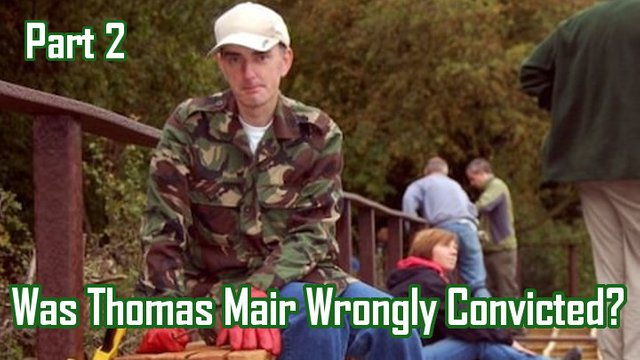
In Part 1 we covered the questionable circumstance surrounding Thomas Mair's arrest for the murder of Jo Cox MP in 2016. Now we will discuss the incredible facts surrounding his trial.
The Bizarre Detention, Trial & Conviction of Thomas Mair.
Regardless of what you believe about Thomas Mair, no one can justifiably deny that his detention and trial was one of the most bizarre episodes in British legal history. It set a significant, dangerous, legal precedent. Yet there has been no comment on this at all by anyone.
Following his arrest in Risedale Avenue, Thomas Mair was first interviewed by West Yorkshire police who charged him with the common law offence of murder. He was not charged under any counter terrorism legislation. Therefore, there was no legal justification to remove him from custody in Yorkshire. Ultimately, he should have been tried at Leeds or Bradford Crown Court. Yet, instead, he was whisked away to be detained in HMP Belmarsh in London.
Allegedly, Thomas Mair was formerly charged at Westminster Magistrates Court on the 18th. At his committal hearing, when asked to confirm his name, he supposedly shouted, “my name is death to traitors, freedom for Britain.” Indicating this was a man with strong political views who wanted his voice to be heard. Yet when he was supposedly interviewed by West Yorkshire police, less than 48hrs earlier, he said absolutely nothing. He didn't confirm his name, say "no comment," or even acknowledge that he was being interviewed. Far from trying to put his political ideology across, there was total silence.
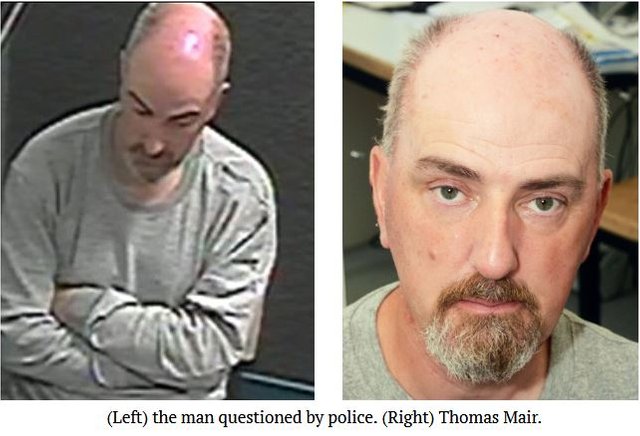
Why? If the man committed to trial in Westminster a few hours later was intent upon loudly declaring political slogans, knowing his interview with police would be used as evidence in court, why didn't he seize the opportunity to expand upon his deeply held racist ideology? He actively sought notoriety by committing the crime, so why not tell the world about his beliefs and convince them of his claimed justification for murder? In light of his reported appearance at Westminster, his silence at all other times made absolutely no sense at all.
Unless the man at Westminster Magistrates Court, who was interviewed by West Yorkshire police and later convicted at the Old Bailey, was not Thomas Mair. This sound like a ridiculous suggestion but Hall provides evidence which strongly suggests this possibility.
For a start no one at the Westminster hearing knew Thomas Mair. There was no independent corroboration that the man in the dock was Thomas Mair. Hall showed photographs of Mair, taken when he was first detained in custody, and the footage of his interview to four people who were his close associates. They all said they didn't think it was Thomas Mair.
If the man being interviewed wasn't Thomas Mair, that would explain his silence. While someone who looked like Mair could visually pass on camera as possibly being him, if he spoke he would also have to match his voice. It is notable that the man interviewed was only seen from a high angle and kept his full gaze averted from the camera, at all times, in the released footage.
Another possibility is that the man was Thomas Mair but that he was given legal advice to say absolutely nothing at all. This would have been essential if Mair was a patsy. If Thomas Mair had started asking, during the interview, questions about why he had been arrested, denying his involvement or claiming he was nowhere near he crime scene, he would be laying the ground for a thorough defence at trial. A completely silent Thomas Mair would enable a 'no defence' trial to proceed.
Having looked at the pictures and video, I disagree with Hall on this, I think that the man interviewed by West Yorkshire police probably was Thomas Mair. However, I cannot ignore the claims of those who knew him, as reported by Hall, who say otherwise. If it was Mair, I suggest he was possibly instructed by his supposed legal team to stay absolutely silent. There would appear to be no other logical conclusions. I do not believe that the man who stood trial was necessarily the same man initially interviewed. Something we'll get to shortly.
We have already explored the strong possibility that the man who supposedly killed Jo Cox was not the man later arrested on Risedale Avenue. If Thomas Mair was a patsy it is usual for them to be killed before they can protest their innocence. Hall speculates that the intention may have been to kill Thomas Mair in the garden on John Nelson Close. If the operation went wrong, and Thomas Mair wasn't where he was supposed to be, this would present a significant problem for those running the deception.
Once the police were involved it would be very difficult to kill the patsy. Damage limitation would next require that under no circumstances at all should the patsy ever get an opportunity to tell their story. Recorded statements to investigators, court appearances, legal defences and the cross examination of evidence would be out of the question. Therefore it is worth noting that the man the court identified as Thomas Mair, at his alleged trial, said just one, barely audible word, offered no defence and there was no significant cross examination of the evidence offered by the state.
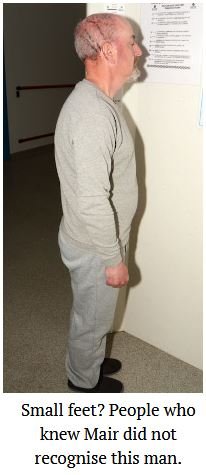
The man supposed to be Thomas Mair, who shouted out "my name is death to traitors" at his committal hearing, didn't even offer a plea in his defence. The not guilty plea was entered by the Crown on his behalf. During his entire five day trial this man, apparently driven by political fanaticism, only quietly said 'yes,' when asked if he was Thomas Mair.
That was it! No further comment, no defence offered, no thorough exploration of any evidence and no attempt to offer mitigation. Nothing, just stony silence as the prosecution made its case without being challenged by anyone. The only semblance of any defence offered by QC Simon Russel Flint was a brief discussion over what Thomas Mair said when he was arrested. Remarkably, Flint's final summation to the Jury could equally have been said by the prosecution:
“You and you alone will determine whether Thomas Mair can return to his quiet and solitary existence or will forever be remembered as the man who assassinated Jo Cox.”
There are two, specific situations which provide legal grounds for offering no defence. Neither of which appeared relevant in the case of Thomas Mair.
If the defence barrister knows for certain that the defendant is guilty then they are somewhat limited, under the Barristers code of conduct, to what they can or cannot say in court. This could make meaningful cross examination virtually impossible, depending upon the nature of the evidence for the prosecution.
If the man called Thomas Mair told Mr.Flint he was guilty, presumably Flint advised Mair to plead guilty. This would undoubtedly have improved sentencing prospects. But the man called Mair must have both admitted guilt and then entered no plea. Thereby forcing a defence at trial. This is not plausible.
It is silly to imagine that Thomas Mair admitted guilt, then refused to plead, forcing a 'not guilty' defence at trial, but then said nothing in court. A high profile trial at the Old Bailey would have been the perfect stage to declare his political beliefs, so pleading 'not guilty' would have provided him that opportunity. Yet the political fanatic, by not to pleading at all, effectively ensured he would be tried with a limited defence, in silence.
Remember, we are told he actively took steps to evade capture. So he wasn't keen on going to prison for as long as possible. Yet we are asked to accept, following legal advice, he not only made every effort to ensure he received the harshest possible punishment, but also refused any and all opportunities to rant about his twisted ideology. Ridiculous as it sounds, this is what we are supposed to believe.
Even though it made no logical sense, we can be certain that an admission of guilt to his defence team must have been the reason why no meaningful defence was made. The only other legitimate reason for not mounting a proper defence wasn't remotely possible.
If the defence can't find anything, or any way, to challenge the prosecutions evidence, they may advise their client not to offer any defence. This is in circumstances where the prosecution's evidence is so overwhelming it is unassailable. The defence may judge that any attempt to challenge the evidence would only serve to further incriminate their client. This was definitely not true in the trial of Thomas Mair.
Any idiot could have driven a truck through the woeful evidence offered by the prosecution at the Old Bailey. Mr flint is an extremely experienced barrister and no idiot, so the lack of a defence can only have been through contradictory admission of guilt, followed by an unfathomable refusal to plead. If it was 'legitimate.'
In short, any claimed justification for not defending Thomas Mair is wholly unbelievable and must be questioned. At the very least, it seems the he was offered some of the worst legal advice in history.
Thomas Mair was convicted on the following evidence:
- The man in the dock was Thomas Mair.
- Witnesses saw the man in the dock murder the victim.
- The murder weapons were found in his possession.
- Forensic evidence tied the murder weapons to the defendant and the victim.
- Evidence proved motive and there were no mitigating circumstances.
- Jo Cox was assassinated.
Regardless of any possible limitations under the barristers code of conduct, Mr Flint QC was free to cross examine the evidence presented by the state. His client was effectively pleading not guilty and, under such circumstances, was entitled to a robust defence. The onus is upon the prosecution to prove guilt, all the defence has to do is demonstrate reasonable doubt. Given how weak the prosecutions evidence was, Hall is absolutely right to question Thomas Mair's conviction.
The Man in the Dock Was Thomas Mair.
No member of Thomas Mair's family were allowed to attend the trial. Why not? The man in the dock did not swear an oath that he was Thomas Mair. None of the witnesses called by the prosecution knew Thomas Mair and none of them saw Thomas Mair being arrested. Apart from one solitary, barely audible 'yes,' the man in the dock did not speak for the entire duration of the trial.
Court artist Julia Quenzla drew pictures, seemingly of the same man, on three separate occasions. Her drawing of the man in the custody video, the man at Westminster Magistrates Court and the Man on trial at the Old Bailey are consistent. This was a man with quite an angular face, sharply defined features, squarish jawline and arched eyebrows which closely met at the bridge of a straight pointed nose. The man had a uniform greying beard, a heavy brow, wrinkled forehead, strongly defined facial creases between the cheeks and the nose and a harsh countenance. He bore only a passing resemblance to Thomas Mair.
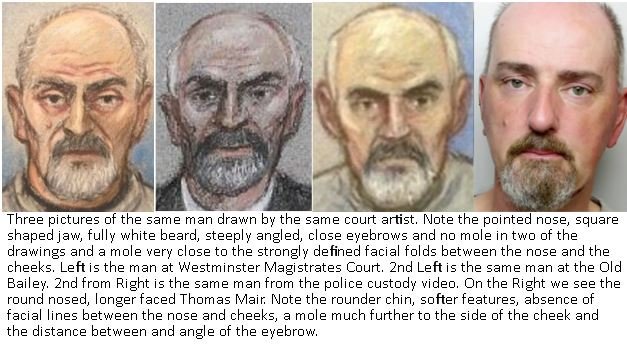
Witness testimony was read out to the court from a neighbour of Thomas Mair's. She stated that she saw him on the morning of the 16th, from her vantage point in a passing bus, walking along carrying an orange bag, wearing a light coloured baseball cap. This witness, who knew Thomas Mair well, was not called to testify, was not in the court and could not identify the man in the dock as Thomas Mair.
Nor were the witnesses to his arrest called by the defence. Their statements weren't even taken by the police. Not only would they have been able to testify whether or not the man arrested was the same man sat in the dock, but could also have testified that the police knew the defendants name before they arrested him.
It is inconceivable that Thomas Mair didn't tell his defence team about the police knowing his name. This alone would have cast immense doubt upon the states narrative. That his defence didn't call any witnesses to his arrest appears, on its own, to suggest a miscarriage of justice. However, it is far from the only reason to suspect Thomas Mair's wrongful conviction.
The prosecution offered a considerable amount of CCTV evidence to the court which Hall has used throughout his documentary. It is patently obvious from reviewing that footage that there is considerable doubt that Thomas Mair, the man arrested, was the same man seen carrying out the attack in the footage. Are we seriously expected to believe that his defence team didn't spot any of the clear anomalies between the recordings? The idea is an absurdity.
At his committal hearing the man shouted out "my name is death to traitors." So, in fact, the man at the committal didn't claim he was Thomas Mair. Not a single person who knew Thomas Mair was at the Westminster hearing. There are no photographs of Thomas Mair arriving at, leaving or in the dock for either court hearing.
There is no evidence at all that the man who stood trial at the Old Bailey was Thomas Mair. In fact the evidence presented suggests he was not. The legal principle of habeas corpus, which literally means "you may have the body" was apparently abandoned in the trial of Thomas Mair. It is the principle that says anyone detained by the state must be presented to a court to determine if that detention is lawful. It seems that didn't happen in this case.
What is certain is that Thomas Mair has been imprisoned for the rest of his life.
Witnesses Saw the Man In The Dock Murder the Victim.
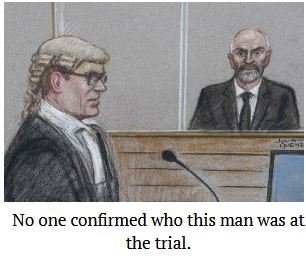
Not one of the witnesses was asked by either the prosecution or the defence to identify the man in the dock as Thomas Mair. Is this because none of them could have done so? Moreover, not a single witness was asked to identify the man in the dock as the killer. This is extremely unusual given the number of witnesses. We must ask why the prosecution didn't assert this obvious evidence at the trial. Could it be they feared the witnesses would have been uncertain?
The man in the dock was not positively identified either as the killer or Thomas Mair. He could have been anybody.
The Murder Weapons Were Found in His Possession.
When apprehended Thomas Mair was carrying a black holdall which he threw to the ground when instructed by the police. He did not come into contact with this bag again. At the trial PC Nichols stated that Thomas Mair had said he had a knife in his pocket. On this occasion the defence objected claiming he said no such thing. However, this objection effectively supported the prosecution because neither arresting officer testified to finding any knife in Thomas Mair's possession.
PC Nichols stated that he found a gun in the bag and PC Wright testified that he felt the bag, without looking inside it, and could perceive the form of a gun. Neither officer stated that they found any knives in the bag. PC Wright also testified that he found a plastic bag of bullets in Thomas Mair's pocket with 'about' eight bullets in it.
The jury were then given unsigned written testimony from an unnamed senior crime scene investigator who supposedly arrived at the site of Thomas Mair's arrest, an hour or so after he was apprehended, at 14.50. Neither the prosecution nor the defence called this investigator as a witness. Ensuring their testimony could not be examined at all, let alone cross examined.
This oversight by the defence is totally inexplicable. The testimony proved the case should have been dismissed there and then. The statement reported that the investigator found a large 'dagger' type knife and a smaller gold knife at the arrest scene, lying on the road. They also stated that the handle of the gun could be seen sticking out of the bag.
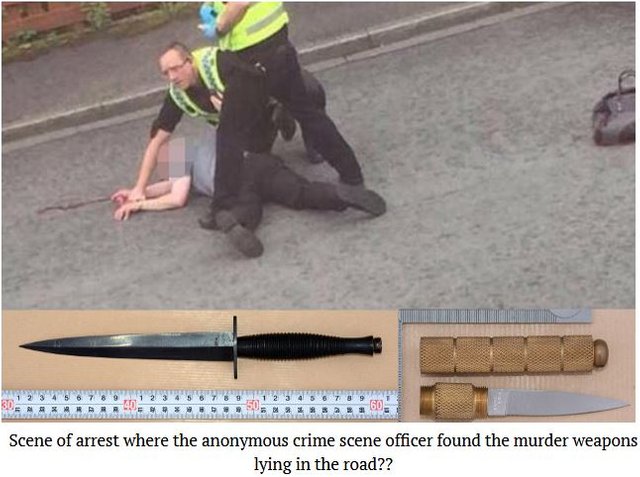
This totally contradicted the sworn testimonies of the arresting officers and the video and photographic evidence at the scene of the arrest. Neither of the officers claimed to have found any knives and certainly didn't see any laying out in the open.
There are no such weapons visible on any of the witness footage of the arrest. It should be noted that this footage had been posted on social media and had been widely circulated.
PC Wright stated that he had 'felt the presence of the gun' and didn't see it. So we are asked to accept that a trained police officer failed to notice the handle of a gun sticking out of a bag belonging to a suspect he had just arrested on suspicion of murder.
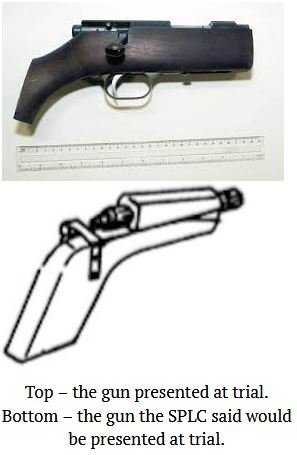
No evidence was ever presented that Thomas Mair had ever acquired any of these weapons. None of the witnesses to the arrest, who weren't called to testify by the defence, saw any knives or a gun.
The idea that an experienced defence barrister was incapable of smashing the states narrative to pieces with this obviously contradictory evidence, which proved the planting of evidence by 'unknown' individuals, is utterly ridiculous.
The gun itself, when presented to the court, was extremely similar in form and function to the gun which the SPLC had suggested would be found, in a story undoubtedly written before Thomas Mair was arrested.
Thomas Mair would have fared much better if he had represented himself.
Forensic Evidence Tied the Murder Weapons to the Defendant and the Victim.
The jury heard that blood from Thomas Mair and Jo Cox were found on the gun and in the bag. They were also told that blood was found on Mair's phone and wallet.
No evidence was presented which suggested the killer sustained any injuries during the attack. No CCTV or witness footage showed any sign of bleeding on either the killer or Thomas Mair. No blood spatter from Jo Cox was found on Thomas Mair's clothing when he was arrested. No DNA evidence, linking Thomas Mair to the murder scene was produced. No evidence of firearm residue on Thomas Mair was presented to the jury.
The evidence showed the first time Thomas Mair bled that day was when he hit his head on the floor as the arresting officers rugby tackled him. This was after he had placed the bag on the ground and he did not touch it again. It seems the only possible way his blood could be in the bag, or on the gun, was if it was planted, like the knives, after his arrest.
His 'defence team' were apparently so incompetent they failed to highlight any of these evidential flaws to the jury.
Evidence Proved Motive & There Were no Mitigating Circumstances.
It is almost beyond belief, but at the trial of Thomas Mair the jury were not asked to consider motive. Establishing motive is one of the most important elements of any criminal trial. In the case of causing a death it is the difference between murder and manslaughter. At no stage did the Crown prosecution mention the word 'terrorism.' The explanation for this is that they did not want the jury to be 'confused' and only wanted them to consider whether or not the man in the dock (whoever he was) killed the victim. This is preposterous.
Thomas Mair was convicted of the common law crime of murder and the jury did not identify any motive. Yet the judge at his Old Bailey trial stated that the murder was inspired by his belief in 'white supremacy' and 'extreme nationalism.' Thomas Mair received a whole life tariff from Mr Justice Wilkie, under schedule 21 Criminal Justice Act 2003. This enabled the judge to announce 'terrorism' as the motive pursuant with Schedule 2 of Counter-Terrorism Act 2008. After the verdict.
Why the jury weren't asked to consider motive is anyone's guess, because they sure were shown a lot of evidence which related to it specifically. They were shown a huge array of far right literature, memorabilia and documents, supposedly demonstrating Thomas Mair's 'far right' fanaticism. 'Motive' in other words. Computer search evidence from both the library and his home computer suggested he was actively searching subjects related to the crime.
Had Thomas Mair had any kind of defence at all, by this stage of the trial, the jury should have been well aware of the high likelihood of planted evidence. Consequently they may have treated this so called evidence with the suspicion it deserved.
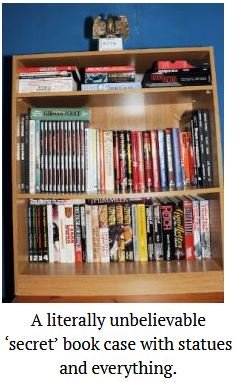
Only minutes after Thomas Mair's arrest police entered his home address on Lowood Lane. Here they found the extensive treasure trove of 'far right' items. Presumably no one who knew Thomas Mair, including all his family members, had ever been in his house, because none of them knew anything about his massive stash of Nazi books, films, artifacts (including a large metal Third Reich eagle on prominent display) and other assorted terrorist related documents.
Perhaps the alleged fact that he kept all this hidden in his bedroom would account for this? Again the suggestion is that the radical far right extremist was very sheepish about his views. But no so sheepish that he wasn't prepared to carry out a politically motivated murder in broad daylight in a busy market town.
Thomas Mair was in custody at the time of the entry and search. Therefore, under the Police and Criminal Evidence Act 1984 (PACE,) the only possible justification the police could legally enter his property without a warrant would be:
"in an attempt to save a life or prevent injury to someone or serious damage to property."
As there was neither any reason to fear anyone else's life was in danger nor any evidence to suggest a threat to property, the police must have had a warrant, signed by a judge, in order to effect legal entry and search. Because otherwise, all the evidence they claimed to have found would have been inadmissible in court. A first year law student would have it thrown out in less than a minute.
Seeing as the police entered his house within minutes of his arrest it seems unlikely they had time to secure a warrant. However, at his trial, this issue wasn't clarified and the defence didn't bother to ask.
Something else first year law students understand is the value of mitigating circumstances. Thomas Mair had suffered bouts of depression and was due to attend a counseling appointment on the day of the attack, having sought support the previous day. The obvious tactic of any defence team would be to explore the possibility that his mental health state contributed to, thereby mitigating to some extent, his alleged actions. They didn't.
Based upon all this probably inadmissible evidence, in addition to the sentencing remarks, the Crown Prosecution Service said Thomas Mair committed an act of terrorism. Yet the fact remains, the jury were only asked to consider if he was guilty of murder, not any terrorist related act. Motive was not established. Terrorism or otherwise.
Jo Cox Was Assassinated.
The most dangerous precedent to emerge from the alarming trial of Thomas Mair was the complete absence of any material evidence of a body. Not all murder trials can provide evidence of a body. Sometimes the victim is never found and the evidence is largely circumstantial. However, where that is not the case, such as in Thomas Mair's trial, if the jury are shown no material evidence of a body there must be significant doubt that the murder took place as described. How could it be otherwise?
To be clear, like Hall, I am by no means certain that Jo Cox didn't lose her life that day. All the witness testimony shows that many people saw what they thought was a murder. I wasn't there, they were. Her body was identified by her sister in a mortuary in Bierley, Bradford. It is reasonable, in light of the evidence presented, to believe that a murder was committed.
However, the fact is the jury at the trial were not presented with any material evidence of a body. Given that her body was supposedly available for evidence, doubt is also entirely reasonable. Moreover, Thomas Mair's defence team's failure to question if the crime happened at all, which was an obvious line of inquiry given the absence of any evidence of a body, is perhaps the single biggest reason to be concerned over the safety of his conviction.
The inquest into Jo Cox' death was opened on 24th June 2016 and then adjourned six minutes later, allowing the body to be released for burial. At the inquest Det Insp Nick Wallen, of West Yorkshire police, said a post mortem had been completed. Det Insp Wallen also stated that Jo Cox was pronounced dead in an ambulance at 13.48 on the 16th. While reports say the inquest was 'adjourned,' there is no record of it ever being reconvened. It appears these six minutes represented the entire extent of the coroners involvement.
In order for a coroners inquest to have any meaning at all, someone, referred to as the informant, has to testify to the inquest that they have seen the body. Notably Jo's sister, who could have been the informant, did not attend the inquest. This is then recorded, by the registrar, on the death certificate. Jo Cox' death certificate reported the cause of death as 'multiple stab and gun shot wounds.' It was not signed by the informant. Nor was the death certificate signed by the registrar.
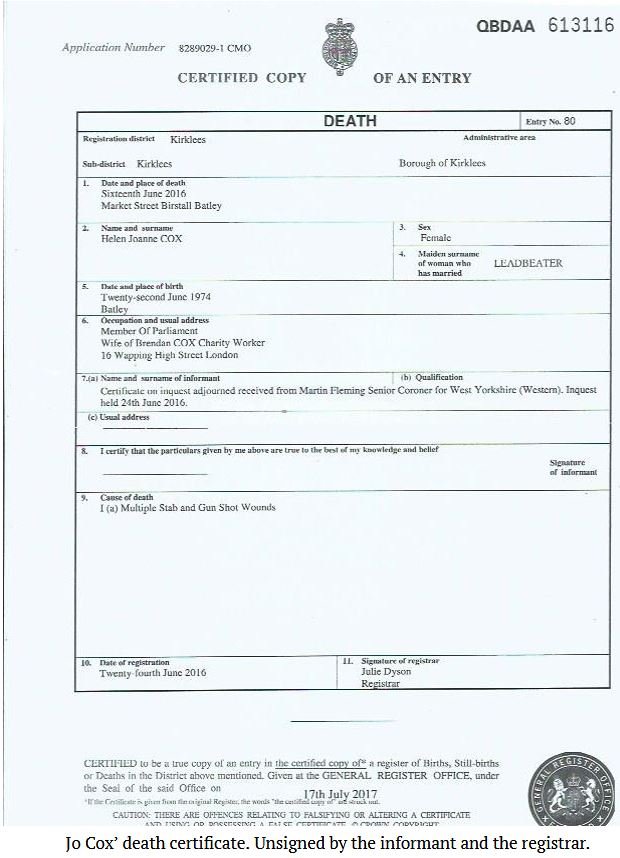
There appears to be no legal record of her death. Yet Thomas Mair's supposed defence never questioned this.
The pathologist who examined Jo Cox was Dr Richard Shepherd. Dr Shepherd has been the pathologist for some very high profile victims. He was the pathologist for victims of the Hungerford Massacre, 9/11, 7/7, Stephen Lawrence and Princess Diana among many others. He was also instrumental in supporting the findings of the pathologist in the death of U.N weapons inspector Dr David Kelly. His 'expert opinion' was heavily relied upon to stop any inquest into Dr Kelly's death. To say he is a 'controversial' pathologist is something of an understatement.
The purpose of a postmortem examination (autopsy) is to establish the precise cause of death. Another important function is that a 'scalpel autopsy,' indicating the depth and force applied to create the wounds, can reveal the intent of the murderer. Were they frenzied or calm and precise? Was it a crime of passion or premeditated assassination? It can also match the injuries to the murder weapon.

Without this vital evidence any half baked defence barrister could have argued that there was no evidence the victim was killed with the alleged murder weapon. Without examining the wounds how does anyone know she was shot with the .22 calibre gun found, or stabbed with either of the knives?
This is an essential procedure which cannot be legitimately overlooked in a murder trial. Yet, at Thomas Mair's trial, that is precisely what happened.
The jury were told that it would be too upsetting for them to see material evidence (photographs) of the wounds and the body. Sitting through a murder trial must be a harrowing experience for any juror, but they absolutely must be shown the evidence. It is not unusual for the jurors to be shown computer generated images (CGI) in addition to physical evidence, but it is unheard of for them only to be shown CGI and no material evidence of a body at all.
This is contrary to the guidance of the UK Chief Coroner on the use of postmortem imaging which states:
"Imaging should not be used as the sole type of postmortem investigation where the circumstances of the death are suspicious or controversial, except where the cause of death is obvious."
Jo Cox reported murder was highly suspicious and very controversial. The precise cause of death for Jo Cox was not 'obvious.' Saying she was stabbed and shot, from an evidential perspective, is no different to saying someone died because they were in a car crash. Describing the event is not a determination of cause of death.
The only evidence that Jo Cox died were witness statements. None of these witnesses testified to seeing any wounds, just lots of blood. There were no photographs showing the body at the scene, none of the body being removed from the scene, no record of the body being received by Leeds infirmary, no postmortem images (apart from cartoons) and no legal death certificate.
Conclusion.
There appears to be evidence which shows that the man who possibly killed Jo cox was not the same man who was arrested on Risedale Avenue. This man was Thomas Mair.
It is impossible to overlook the clear evidence which indicates that the police were looking for Thomas Mair by name, within minutes of the alleged crime. At that stage, if the crime was genuinely as described, they could not possibly have known the killers name. It is reasonable to suspect that Thomas Mair was the designated patsy for some kind of operation by persons unknown.
The SPLC could not have researched and written their hit piece on Mair, so soon after the murder, if they didn't already know who he was. This indicates that the narrative, painting Thomas Mair as the far right extremist, was prepared in advance of his arrest. Again, suggesting he was a patsy. That not one person who knew him could believe he even held strong political views, let alone that he was capable of committing an extremist act, cannot easily be ignored.
The total silence of the man interviewed by West Yorkshire police is inexplicable. Either this man wasn't Thomas Mair or he had been given legal advice designed to deliberately harm his own case. There are solid grounds to believe the man who shouted out at Westminster Magistrates Court, and later stood for trial at the Old Bailey, was not Thomas Mair. That no one who knew him were permitted to attend his trial is also notable.
Thomas Mair was quite possibly convicted in absentia (no habeas corpus) and sentenced to life in prison without any defence at all. Despite the complete absence of any challenge to the state's evidence, it was still painfully thin, self contradictory and strongly suggested Thomas Mair was framed.
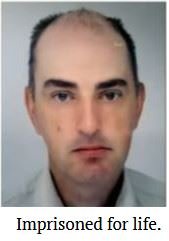
No witnesses testimony placed Thomas Mair at the scene of the crime; there was no forensic or ballistic evidence placing him at the scene; the strong possibility of planted evidence repeatedly emerged during the trial; normal forensic procedures were ignored; standard documentation was missing or incomplete and, for the first time in British legal history, despite the alleged presence of a body, no material evidence of a death was presented to the jury in a murder trial.
Like Hall I believe Thomas Mair was wrongfully convicted in one of the worst miscarriages of justice ever perpetrated in Britain. It suggests corruption at the highest level and appears to be a terrifying example of the unbridled misuse of state power.
However that is just my opinion and you must make yours.
Meanwhile, Thomas Mair will remain in prison for the rest of his life.
Take it easy you hoopy froods.
